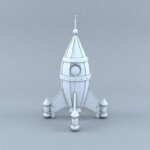As an essential component in the fields of aerospace, energy and electric power, impellers have strict requirements for precision and quality and are difficult to process. The following is an introduction to common treatment techniques.
Preliminary preparation
According to the design drawings of the impeller, accurately analyze its structure, size, blade shape (such as straight blades, twisted blades) and precision requirements, etc., and select suitable blank materials, mainly aluminum alloy, stainless steel, titanium alloy, etc. , to meet the requirements of strength, corrosion resistance and other working conditions, and then use flaw detection and other inspections to ensure that the blank has no internal defects.
draft
1. Tightening and positioning: choose a suitable accessory, such as a special shaft accessory, and position and tighten from the center hole of the wheel to ensure stability and precise positioning, and reduce deformation and displacement of the wheel. treatment.
2. Roughing strategy: on a five-axis machining center, use a large diameter tool (such as a bullnose tool) to cut according to the allowance and layer height, quickly remove the most of the excess thickness, set reasonable cutting parameters, and the spindle speed is several thousand rpm, the feed rate is several hundred millimeters per minute, and the cutting depth is determined by the material and the tool. Priority is given to treatment areas such as flow channels and hubs, leaving a margin of 0.5-1mm. margin for subsequent fine processing of the blades.
Blade finish
1. Tool adaptation: According to the curvature and precision of the blade, select a spherical cutter or a conical spherical cutter. Small diameter cutters can reach the intricate contours of the root and top of the blade.
2. Five-axis linkage machining: Using the five-axis machining center, the tool can be accurately moved along the complex curve of the blade space, the axis vector cutting speed can be controlled to adapt to changes in the blade surface, and the tool path can be continuously optimized to ensure that the blade surface roughness reaches Ra0.8 – 1.6 microns , as for the blades of aviation turbine, surface accuracy should be strictly controlled within ±0.05mm.
Finishing the runners
Use ball milling cutter, five-axis linkage and high-speed cutting, set high speed (tens of thousands of rpm), low feed, and “climb the knife” along the surface of the channel. ‘flow to make a smooth transition on the flow channel wall and precise dimensions, ensuring a smooth connection with the blades to prevent airflow turbulence from affecting the performance of the impeller.
Post-processing and testing
After processing, remove burrs, oil stains, etc., perform dynamic balance testing, dimensional accuracy measurement (calipers, three-dimensional coordinate measuring instrument to measure key dimensions, geometric tolerances), surface quality inspection (ultrasonic, magnetic particle inspection to detect microscopic ones). cracks) and correct deviations based on the inspection results, thereby ensuring high-quality delivery of wheels.
Daguang focuses on providing solutions such as precision CNC machining services (3-axis, 4-axis, 5-axis machining), CNC milling, 3D printing and rapid prototyping services.

















